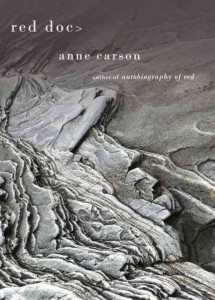I would like to suggest that Anne Carson’s Red Doc> is a clock, a clock that takes the measure of its readers and their world by entrancing them with anachronism and myth.
It’s also, of course, a follow-up to her 1998 novel in verse, Autobiography of Red. Set in a world at once contemporary and mythic, both works elaborate on the ancient Greek myth of the red, winged monster Geryon, vanquished by Herakles (aka Hercules). Carson’s Autobiography is a monster’s kunstlerroman, the story of sensitive, artistic Geryon’s childhood and adolescence and his creative attempts to document his red life.
I first read Autobiography at a coffeeshop in Chicago. It was 2004; everyone went to Filter to smoke. I turned a page. The smoke fluttered. “Geryon was trying /to breathe but a red wall/had sliced the air in half.” His lover, Herakles, was breaking up with him, urging him to catch the bus back from Hades to his mother’s house on an island called the Red Place. Silvery ribbons looped from the black plastic ashtray, garlanding the book. Carson leaves wounded teenage Geryon flexing his wings at the lip of a Peruvian volcano. It’s only in hindsight that I notice it was smoky.
Red Doc>, published fifteen years later, locates Geryon (now called “G”) after a similar interval of time. In aging Geryon and his friends roughly at pace with the world, Red Doc> manages to tell, along with Geryon’s story, something of the toll the last 15 years have taken on all of us, and on the earth. The characters’ grief for losses sustained in their anachronistic, mythic world becomes an elegy for losses in our own world.
Carson grants both the future and the past the power of movement, the power to advance and impinge upon the present moment that we (to some degree) share with the characters. In Red Doc> time has at last confiscated Herakles — bold and youthful for two thousand years — and reassembled him as an aging warrior known as “Sad But Great” or just “Sad.”
The novel begins with dialogue featuring rumors about Sad’s fate; two voices assemble the tale of his transformation:
. . . I miss her martinis [stubs cigarette] so what’s he
up to now/just got out of
the army/ wounded/
messed up/are they giving him care/a guy shows
up with a padded envelope
of drugs every night I
guess
it’s care
Like many veterans of the wars of the 21st Century, the hero Herakles (now Sad) has returned home changed. “Messed up” Sad suffers from flashbacks, and struggles, like Red Doc> itself, to see the present entirely as such. Sad is “at this moment staring at/Ida and seeing the most/grievous day of his life/rematerialize before him” while a “wave of war” – perhaps the 21st Century war suggested in Red Doc>, perhaps the violence characterizing Greek mythology — “bears him along” into a future. The past and future materialize in Red Doc>, so much so that reading the novel sent me in pursuit of Carson’s “real” references, both recent headlines and classical sources.
“To stand in time with your/back to the future your/face to the past what a/relief it would be” muses war veteran 4NO, a character in Red Doc> whose vision of the present is compromised by foresight. Red Doc>, as both sequel to Autobiography and a meditation on earlier mythology, points us to the questionable pleasures of hindsight. In Red Doc>, Carson explores questions like: can studying the past help us to understand the present or to prepare for the future? Do we need hindsight? Are the past and present continuous? Overlapping? For 4NO, “every molecule” of the future “is advancing. . .like perfect/works of art they form a/sparkling flood. They saturate him and/confiscate the present moment.”
Carson asserts that “time [is] paper folded to look like a mountain,” and, in pointing simultaneously toward the past and the present, she shows us that what stands between contemporary readers and the ancient world only appears to be substantial. Like paper, mountains in both Red books are flammable, ticking time bombs destined to erupt and send forth wavy, rolling lines of lava which might, after all, be verse.
Peering into the prose “documents” that account for history from a safe distance, Carson suggests, we risk falling into the active, generative abyss, a volcanic past that promises to flow into the present and freeze itself over our shapes: Here we are where Herakles eats MREs. Our mythic heroes suffer from PTSD. We’re about to be covered up with ash, even though no one smokes anymore.
At one point in the novel, characters seek refuge inside a glacier, where they discover a secret military prison/nursing facility overseen by the Chief Medical Officer (CMO), “a minotaur who swallows/other people’s labyrinths.” It doesn’t matter what mythic or military power the CMO has. A glacier perched on top of an active volcano is destined, like our own glaciers, to melt; it’s only a matter of time. In Red Doc>, as in our world, discussions of violent conflicts have overshadowed renderings of environmental changes. But (as one of Carson’s narrators chides readers who may have been neglected to notice signs and foreshadowing) “don’t say you weren’t/expecting a volcano.”
This post may contain affiliate links.









